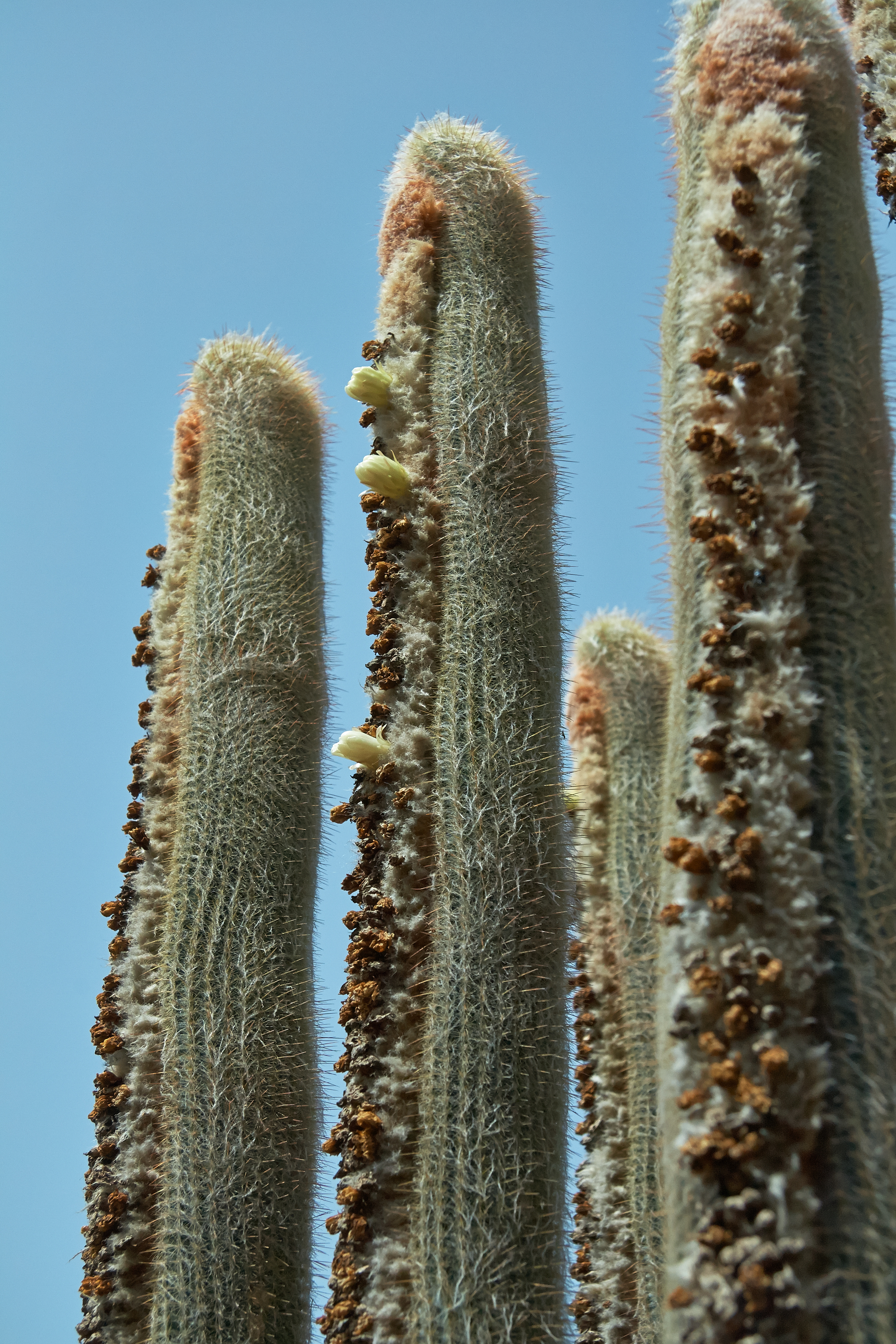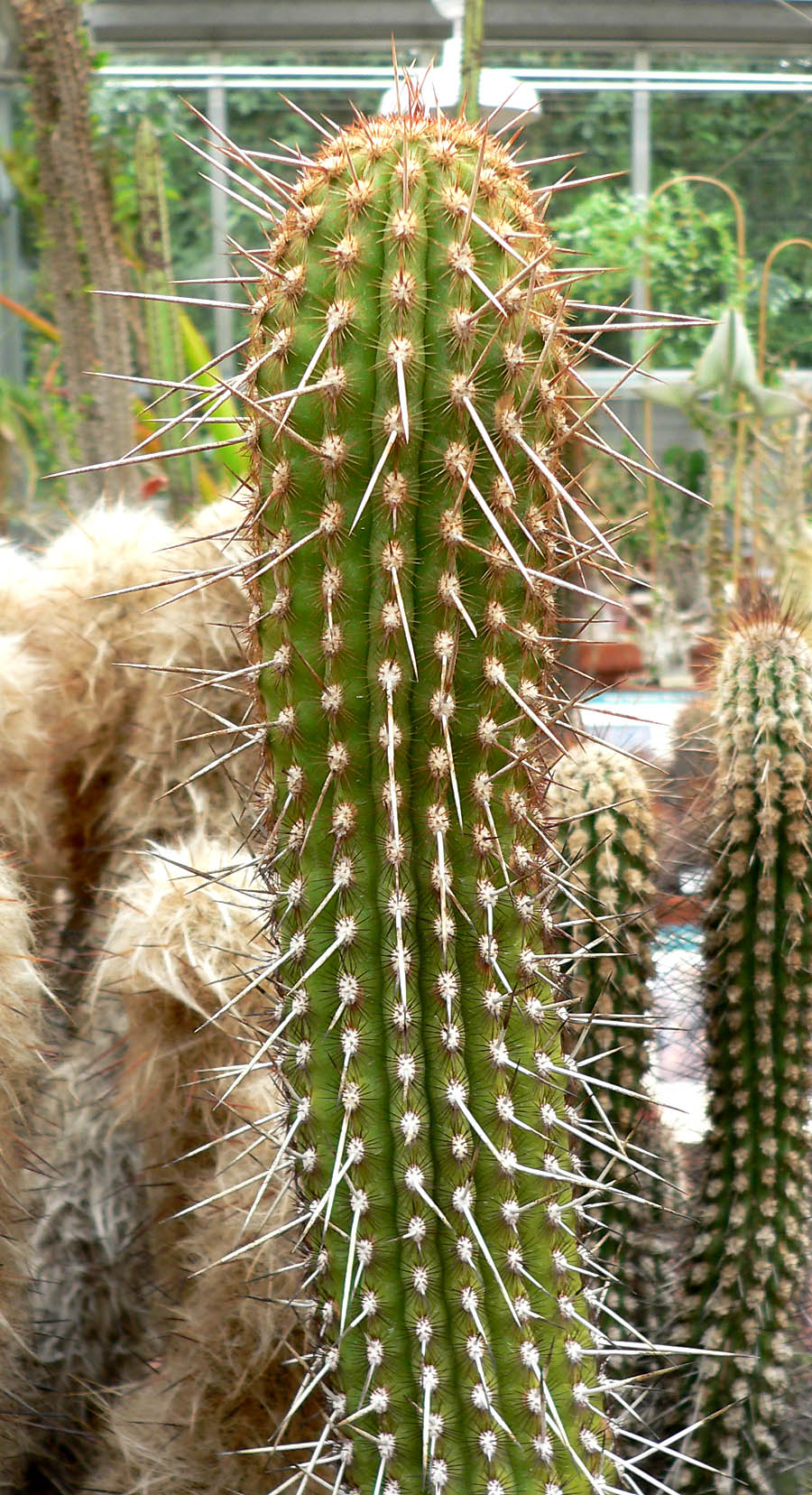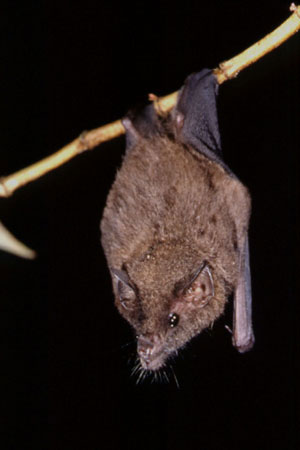|
Espostoa
''Espostoa'' is a genus of columnar cacti, comprising 16 species known from the Andes of southern Ecuador and Peru. It usually lives at an altitude of between 800m and 2500m. Its fruit is edible, sweet, and juicy. The genus is named after Nicolas E. Esposto, a renowned botanist from Lima. These candle-like cacti are covered with spines and white hair. Only the older specimens can divide. In adulthood, a cephalium sometimes appears, similar to the Mexican genus Cephalocereus. They were discovered by Alexander von Humboldt and Aimé Bonpland in the early nineteenth century. They are appreciated for their decorative qualities due to their white fleece. They can be propagated by seed. For full development they must be planted in the ground. The cultivated specimens very rarely flourish. Like all cacti, Espostoa requires a sunny location and well-drained soil. But in summer, it appreciates fertilizer and wetter conditions. In winter, it needs a rest, but the temperature must not ... [...More Info...] [...Related Items...] OR: [Wikipedia] [Google] [Baidu] |
Espostoa Lanata
''Espostoa lanata'' (= Wooly Espostoa) is a species of cactus of the genus '' Espostoa''. Its common names are Peruvian old man cactus, cotton ball cactus, snowball cactus, snowball old man. Habitat Its original habitat is from southern Ecuador to the northern Peru on the west slopes of the Andes mountains. Description ''Espostoa lanata'' is a columnar cactus. It looks like ''Cephalocereus senilis'' (the Old Man of Mexico) : it is a densely hairy species, covered by a warm woolly coat and well adapted to high altitudes. The main difference is the presence of sharp spines on ''Espostoa''. It is widespread in its habitat and quite variable in size and spines, and for this reason it has received several names. The plant is a column up to 7 meters tall in the wild, but only 3 meters when cultivated. The diameter is from 5 to 20 cm. There are 18 to 25 ribs. The ribs and the sharp are mainly hidden by tissue woolly. It branches only after several years. It flowers at ni ... [...More Info...] [...Related Items...] OR: [Wikipedia] [Google] [Baidu] |
Espostoa Nana 1
''Espostoa'' is a genus of columnar cacti, comprising 16 species known from the Andes of southern Ecuador and Peru. It usually lives at an altitude of between 800m and 2500m. Its fruit is edible, sweet, and juicy. The genus is named after Nicolas E. Esposto, a renowned botanist from Lima. These candle-like cacti are covered with spines and white hair. Only the older specimens can divide. In adulthood, a cephalium sometimes appears, similar to the Mexican genus Cephalocereus. They were discovered by Alexander von Humboldt and Aimé Bonpland in the early nineteenth century. They are appreciated for their decorative qualities due to their white fleece. They can be propagated by seed. For full development they must be planted in the ground. The cultivated specimens very rarely flourish. Like all cacti, Espostoa requires a sunny location and well-drained soil. But in summer, it appreciates fertilizer and wetter conditions. In winter, it needs a rest, but the temperature must not ... [...More Info...] [...Related Items...] OR: [Wikipedia] [Google] [Baidu] |
Espostoa Lanata-IMG 1935
''Espostoa'' is a genus of columnar cacti, comprising 16 species known from the Andes of southern Ecuador and Peru. It usually lives at an altitude of between 800m and 2500m. Its fruit is edible, sweet, and juicy. The genus is named after Nicolas E. Esposto, a renowned botanist from Lima. These candle-like cacti are covered with spines and white hair. Only the older specimens can divide. In adulthood, a cephalium sometimes appears, similar to the Mexican genus Cephalocereus. They were discovered by Alexander von Humboldt and Aimé Bonpland in the early nineteenth century. They are appreciated for their decorative qualities due to their white fleece. They can be propagated by seed. For full development they must be planted in the ground. The cultivated specimens very rarely flourish. Like all cacti, Espostoa requires a sunny location and well-drained soil. But in summer, it appreciates fertilizer and wetter conditions. In winter, it needs a rest, but the temperature must not ... [...More Info...] [...Related Items...] OR: [Wikipedia] [Google] [Baidu] |
Espostoa Hylaea
''Espostoa'' is a genus of columnar cacti, comprising 16 species known from the Andes of southern Ecuador and Peru. It usually lives at an altitude of between 800m and 2500m. Its fruit is edible, sweet, and juicy. The genus is named after Nicolas E. Esposto, a renowned botanist from Lima. These candle-like cacti are covered with spines and white hair. Only the older specimens can divide. In adulthood, a cephalium sometimes appears, similar to the Mexican genus Cephalocereus. They were discovered by Alexander von Humboldt and Aimé Bonpland in the early nineteenth century. They are appreciated for their decorative qualities due to their white fleece. They can be propagated by seed. For full development they must be planted in the ground. The cultivated specimens very rarely flourish. Like all cacti, Espostoa requires a sunny location and well-drained soil. But in summer, it appreciates fertilizer and wetter conditions. In winter, it needs a rest, but the temperature must not ... [...More Info...] [...Related Items...] OR: [Wikipedia] [Google] [Baidu] |
Espostoa Hylaea 1zz
''Espostoa'' is a genus of columnar cacti, comprising 16 species known from the Andes of southern Ecuador and Peru. It usually lives at an altitude of between 800m and 2500m. Its fruit is edible, sweet, and juicy. The genus is named after Nicolas E. Esposto, a renowned botanist from Lima. These candle-like cacti are covered with spines and white hair. Only the older specimens can divide. In adulthood, a cephalium sometimes appears, similar to the Mexican genus Cephalocereus. They were discovered by Alexander von Humboldt and Aimé Bonpland in the early nineteenth century. They are appreciated for their decorative qualities due to their white fleece. They can be propagated by seed. For full development they must be planted in the ground. The cultivated specimens very rarely flourish. Like all cacti, Espostoa requires a sunny location and well-drained soil. But in summer, it appreciates fertilizer and wetter conditions. In winter, it needs a rest, but the temperature must not ... [...More Info...] [...Related Items...] OR: [Wikipedia] [Google] [Baidu] |
Espostoa Cremnophila
''Espostoa'' is a genus of columnar cacti, comprising 16 species known from the Andes of southern Ecuador and Peru. It usually lives at an altitude of between 800m and 2500m. Its fruit is edible, sweet, and juicy. The genus is named after Nicolas E. Esposto, a renowned botanist from Lima. These candle-like cacti are covered with spines and white hair. Only the older specimens can divide. In adulthood, a cephalium sometimes appears, similar to the Mexican genus Cephalocereus. They were discovered by Alexander von Humboldt and Aimé Bonpland in the early nineteenth century. They are appreciated for their decorative qualities due to their white fleece. They can be propagated by seed. For full development they must be planted in the ground. The cultivated specimens very rarely flourish. Like all cacti, Espostoa requires a sunny location and well-drained soil. But in summer, it appreciates fertilizer and wetter conditions. In winter, it needs a rest, but the temperature must not ... [...More Info...] [...Related Items...] OR: [Wikipedia] [Google] [Baidu] |
Espostoa Calva
''Espostoa'' is a genus of columnar cacti, comprising 16 species known from the Andes of southern Ecuador and Peru. It usually lives at an altitude of between 800m and 2500m. Its fruit is edible, sweet, and juicy. The genus is named after Nicolas E. Esposto, a renowned botanist from Lima. These candle-like cacti are covered with spines and white hair. Only the older specimens can divide. In adulthood, a cephalium sometimes appears, similar to the Mexican genus Cephalocereus. They were discovered by Alexander von Humboldt and Aimé Bonpland in the early nineteenth century. They are appreciated for their decorative qualities due to their white fleece. They can be propagated by seed. For full development they must be planted in the ground. The cultivated specimens very rarely flourish. Like all cacti, Espostoa requires a sunny location and well-drained soil. But in summer, it appreciates fertilizer and wetter conditions. In winter, it needs a rest, but the temperature must not ... [...More Info...] [...Related Items...] OR: [Wikipedia] [Google] [Baidu] |
Espostoa Blossfeldiorum
''Espostoa'' is a genus of columnar cacti, comprising 16 species known from the Andes of southern Ecuador and Peru. It usually lives at an altitude of between 800m and 2500m. Its fruit is edible, sweet, and juicy. The genus is named after Nicolas E. Esposto, a renowned botanist from Lima. These candle-like cacti are covered with spines and white hair. Only the older specimens can divide. In adulthood, a cephalium sometimes appears, similar to the Mexican genus Cephalocereus. They were discovered by Alexander von Humboldt and Aimé Bonpland in the early nineteenth century. They are appreciated for their decorative qualities due to their white fleece. They can be propagated by seed. For full development they must be planted in the ground. The cultivated specimens very rarely flourish. Like all cacti, Espostoa requires a sunny location and well-drained soil. But in summer, it appreciates fertilizer and wetter conditions. In winter, it needs a rest, but the temperature must not ... [...More Info...] [...Related Items...] OR: [Wikipedia] [Google] [Baidu] |
Espostoa Blossfeldiorum 03 Ies
''Espostoa'' is a genus of columnar cacti, comprising 16 species known from the Andes of southern Ecuador and Peru. It usually lives at an altitude of between 800m and 2500m. Its fruit is edible, sweet, and juicy. The genus is named after Nicolas E. Esposto, a renowned botanist from Lima. These candle-like cacti are covered with spines and white hair. Only the older specimens can divide. In adulthood, a cephalium sometimes appears, similar to the Mexican genus Cephalocereus. They were discovered by Alexander von Humboldt and Aimé Bonpland in the early nineteenth century. They are appreciated for their decorative qualities due to their white fleece. They can be propagated by seed. For full development they must be planted in the ground. The cultivated specimens very rarely flourish. Like all cacti, Espostoa requires a sunny location and well-drained soil. But in summer, it appreciates fertilizer and wetter conditions. In winter, it needs a rest, but the temperature must not ... [...More Info...] [...Related Items...] OR: [Wikipedia] [Google] [Baidu] |
Espostoa Melanostele Pm02
''Espostoa'' is a genus of columnar cacti, comprising 16 species known from the Andes of southern Ecuador and Peru. It usually lives at an altitude of between 800m and 2500m. Its fruit is edible, sweet, and juicy. The genus is named after Nicolas E. Esposto, a renowned botanist from Lima. These candle-like cacti are covered with spines and white hair. Only the older specimens can divide. In adulthood, a cephalium sometimes appears, similar to the Mexican genus Cephalocereus. They were discovered by Alexander von Humboldt and Aimé Bonpland in the early nineteenth century. They are appreciated for their decorative qualities due to their white fleece. They can be propagated by seed. For full development they must be planted in the ground. The cultivated specimens very rarely flourish. Like all cacti, Espostoa requires a sunny location and well-drained soil. But in summer, it appreciates fertilizer and wetter conditions. In winter, it needs a rest, but the temperature must not ... [...More Info...] [...Related Items...] OR: [Wikipedia] [Google] [Baidu] |
Espostoa Frutescens
''Espostoa frutescens'' is a plant in the family Cactaceae. Description ''Espostoa frutescens'' grows as a cactus. The species relies on nectar bats (including Geoffroy's tailless bat) for pollination. To facilitate the bats' echolocation, the plant's flowers are surrounded with a sound-absorbent furry area resulting in stronger flower echoes. Distribution and habitat ''Espostoa frutescens'' is endemic to Ecuador and confined to Loja, El Oro and Azuay Azuay (), Province of Azuay is a province of Ecuador, created on 25 June 1824. It encompasses an area of . Its capital is Cuenca. It is located in the south center of Ecuador in the highlands. Its mountains reach above sea level in the nationa ... provinces. Its habitat is open areas in dry forests from to altitude. References Trichocereeae Cacti of South America Endemic flora of Ecuador Flora of the Andes Near threatened flora of South America {{Cactus-stub ... [...More Info...] [...Related Items...] OR: [Wikipedia] [Google] [Baidu] |
Cephalium
Cephalium is a frequently brightly coloured structure of wool and bristle at the growing tip of certain cacti. It is most commonly found on cacti of the genus ''Melocactus'' and can take a number of colours, forms and shapes. The cephalium will only begin growing after a cactus has reached a certain size or age. Once flowering begins the flower buds will form from the cephalium. Image:Arrojadoa penicillata.jpg, Flowers emerge from cephalium of '' Arrojadoa penicillata''. Image:Melocactus matanzanus 1.jpg, Cephalium of ''Melocactus matanzanus ''Melocactus matanzanus'', common name dwarf Turk's-cap cactus or Turk's-cap cactus, is a cactus in the genus ''Melocactus'' of the family Cactaceae. The epithet ''matanzanus'' is derived from the Cuban province of Matanzas. Description ''Meloc ...'' Image:Espostoa lanata-IMG 1935.jpg, Lateral cephalium of '' Espostoa lanata'' External links * http://www.cactus-art.biz/note-book/Dictionary/Dictionary_C/dictionary_cephalium.htm {{Ca ... [...More Info...] [...Related Items...] OR: [Wikipedia] [Google] [Baidu] |







